Day 5
May 8, 2003
(Thursday)
Livorno, Italy
At dinner last night, they featured several French specials in honor of the Nice anchorage.
Laura had duck, Robert had snails and frog legs that he says taste just like alligator.
5:00 am
We are up at this ungodly hour, not because of our jet lag (which we seem to finally have
gotten over), but because we have an all-day tour that demands we show up at some frightening
hour to board a bus.
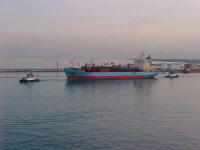
Two tugs pull a boat in Livorno harbor
6:35 am
At each port, part of the food is "cultural" and features local cuisine. Italian
food at breakfast includes Italian sausages and spinach tofu soup, tofu being a traditional
Italian dish, apparently...
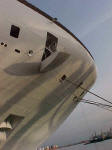
Gangway to nowhere...
7:26 am
We board our tour bus and head for Florence ("Firenze" is how the Italians say it,
for some odd reason). Our tour guide is Luca, which is Italian for Luke.
Livorno (which is where the boat parked) is the port for Florence and Pisa. Mostly it is an
industrial port, and we get a lovely scenic view of cranes and container ships. Florence is
the main urban area, but it is about an hour away.
Pisa used to be the main port of Tuscany, but about 500 years ago, they moved it to Livorno.
We're puzzled by this, too. Pisa is inland (although on the river Arno) and Livorno is on the
coast. Why would you ever have an inland port when you had a perfectly good coastal port? The
answer seems to be "because we're Italian."
On the drive in, we see many Mediterranean pines, which are also called "umbrella
pines" because they look like open umbrellas. These, apparently, are the source of pine
nuts, used in making many Italian dishes (Luca shares his pesto recipe with us--cautioning us
to use a wooden mortar and "pistol" to mash the basil and pine nuts together).
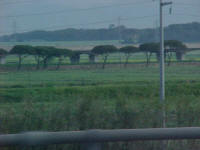
Some umbrella pines on the way to Florence
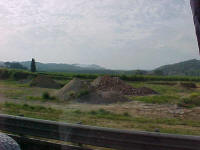
Mounds of dirt
8:00 am
Most of the things we see as we pass through the Tuscany district on our way to Florence are
pretty recent. Bear in mind, however, that "recent" here means "only 800 years
old." Many vineyards (Chianti grapes) and olive groves.
Pisa has some "old" stuff, meaning, "dating back to the Roman Empire." In
fact, Luca says that recently 16 Roman ships were found in the Pisa harbor and are being
carefully excavated so they can see what Roman sailors did. Although Florence existed at that
time, it was pretty much filled with peasants, who didn't do anything interesting.
The Arno is the important waterway around here, and it runs through the center of Florence and
turns up all over the place between Florence and Pisa. We're driving along the Arno river
valley as we make our way to Florence.
9:30 am
We arrive in Florence. They don't allow cars and buses into downtown Florence, and once we get
there we see why. All the roads are five foot wide alleys.
We start off at the "center of the city" which the Florentines cleverly marked with
a column. That's all that's there. A big, empty square and a column.
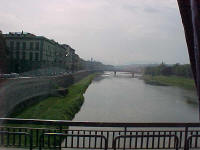
Approaching downtown Florence
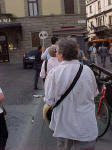
Laura follows our guide Luca (holding the A4 "lollipop")
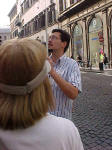
Luca in downtown Florence
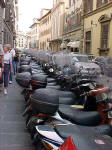
Rows of scooters are a common sight in Florence
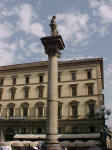
Ground Zero in Florence (the column at the center of the city)
9:53 am
At the next big square (the Square of the Lords), we get a view of Michelangelo's David. Well,
not the real one, but a clever imitation (I can't believe it's not David™ brand
statuary). It's the same size and made from the same marble, but it's not the original (the
original is in the Academy of Arts someplace nearby).
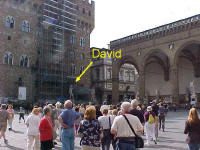
This is the square where David hangs out (you can see him just to the right of the
scaffolding on the building)
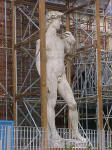
It looks real, but it's a fake
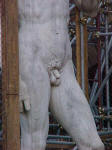
Yup, he's anatomically correct!
Ironically enough, the statue of David is about the same size as Goliath (17 feet). It took
Michelangelo three years to make this monster, but it was a real shrewd career move for him.
After he finished it, he was famous and was able to raise his rates and do pretty much
whatever he wanted to.
Once David was put in the square, everybody wanted to get into the act, so there's a bunch of
other statues by other sculptors there. The ones that were commissioned by the various Dukes
of Savoy all have the faces of the dukes. So, the giant statue of Neptune has the face of the
duke (we thought it didn't look like Neptune...).
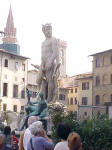
Neptune, with the face of a Duke
There's also a statue of Lorenzo de Medici, which we thought remarkable because there was
nearly always a pigeon sitting on his head, making him look ridiculous. Probably not what he
had in mind when he commissioned it.
Out of the forest of statues, only two (besides David) are really special. One is of Perseus
holding the severed head of Medusa (with the body of Medusa below and guts coming out her
severed neck). This statue is made of cast bronze and the entire thing (about 10 feet tall)
was done in one casting. It took the guy about 10 years to get it right (you can see the seam
along Perseus' leg).
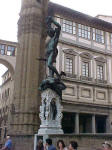
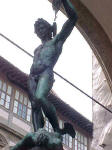
The cast bronze statue of Perseus with Medusa's head
The other special one is called the "Rape of the Sabines" and is made from marble
(it's not nearly as lascivious as the title sounds, it's three figures groping upwards). The
deal with this one is that Bellini (circa 1583) made a bet with the dukes that he could make
three statues out of one block of marble. He won the bet.
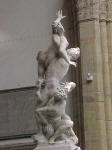
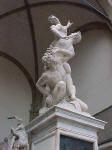
The three-in-one statue
The amazing thing is the detail on this baby. It looks like it was made from some soft pliable
material, not cold, hard marble. One guy has his hand on a female butt, and you can see where
his fingers impress the flesh. Yow!
Sadly, there isn't time to visit the Uffizi Palace of the Arts, full of famous paintings, but
the concourse is full of sculptures of famous people--Galileo, Machiavelli, daVinci.
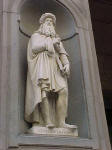
Statue of Leo
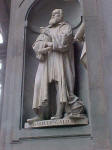
Galileo also has a statue
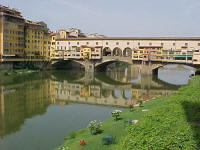
A view of the Ponte Vecchio (Old Bridge)
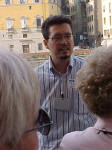
Luca lectures us about Florentine stuff
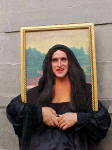
This guy was hanging around, taking donations for doing this (is she smiling, or not?)
10:30 am
We enter the district of the Church of the Holy Cross. And, hoo boy, is this one big
church! It dominates the square, and has a really (really) ornate facade. The deal is that the
church was a monastery (still is, actually), but had kind of a sleazy front. So sometime in
the 1800s, the Englishman Lord Sloane took up a collection among his friends to pay for a
fancy-schmancy facade for it. Oddly enough, Sloane was Jewish, so the monks commemorated his
generosity with big star of David at the top of the facade.
The big attraction of the church, however, is that a whole mess of famous Italians are buried
inside. The really famous ones have fancy memorials (about ten feet across) with statues and
stuff. Luca was very proud that Michelangelo was there, but we thought it was way
cooler that Galileo had a tomb there. Apparently, they stashed him in the courtyard for a 100
years or so until his ill favor with the church cooled down enough for them to get away with
building him a fancy tomb.
Dante and Machiavelli are also buried there, and there's a memorial to Marconi (inventor of
wireless radio) and Enrico Fermi (nuclear scientist, first atomic chain reaction underneath
the University of Chicago basketball court in 1939).
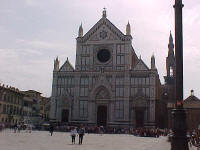
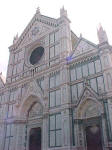
Church of the Holy Cross
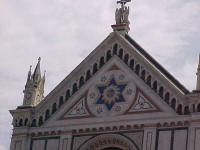
The Star of David at the top of the church in honor of Lord Sloane
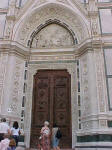
Door to the Church of the Holy Cross
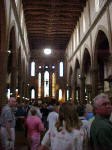
Inside Church of the Holy Cross
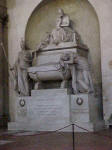
Mikey's tomb
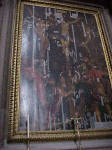
Water damaged picture from the big flood in 1966
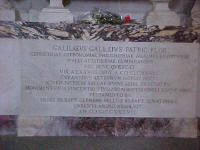
Galileo's tomb
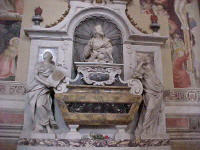
The statue part of Galileo's tomb
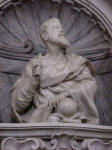
Close-up of Galileo--that's a telescope (not a cigar) in his hand
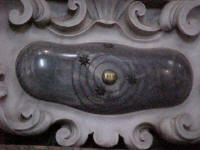
Detail, showing the four moons of Jupiter discovered by Galileo (the church wasn't quite
ready to concede that the sun was the center of the Solar System, but they could buy into the
planet-moon thing)
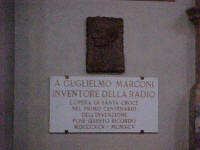
Plaque honoring Marconi, who invented radio
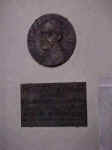
Monument to Enrico Fermi, who put together the first nuclear chain reaction
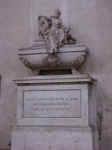
Machiavelli's tomb (the epithet translates as "No praise is sufficient for so great a
man")
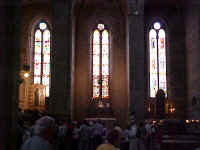
At the far end of the church are some dandy stained glass windows
11:50 am
We get some free time to blow some money at a genuine Italian leather joint (Robert gets a
handmade Italian deer skin wallet "Maybe it's Bambi's mom!" and has it monogrammed
by the in-house goldsmith).
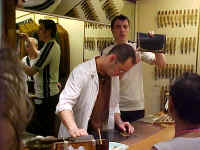
Guy on right is talking about how the gold embossing process is done, while guy on left is
actually doing it
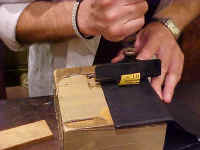
Robert's wallet gets embossed
We're waiting with our guide when a scuffle breaks out and we see a guy wrestling with an
Asian woman who was selling scarves. Before we could change into our Superman costumes, Luca
said, "It's okay, he's police."
Seems that the scarf-selling lady was also a pickpocket and had snagged a tourist's wallet. At
which point, the plainclothes cops moved in to bust her. They got the wallet and all her
scarves, but she took off like a rabbit.
We keep getting warned about pickpockets (and we pay attention to the warnings!), but this
kind of brings it home. Especially since this lady had been trying to sell Laura a scarf not
ten minutes earlier (Laura wisely kept her distance).
(We asked Luca how he knew the guy was a cop, since he was in plain clothes. He said,
"Police dress like thugs, but they look you in the eye. Real crooks look behind
you." It didn't exactly track for us, either...)
12:19 pm
Now we go to see a real church, not a tiny one like the Church of the Holy Cross. We go
see the Cathedral of Florence (Mary of the Flower), which can hold up to 25,000 people. (We
bet that their announcements go on a long time!)
It's a massive church (from a block away, you can't get all of it in the picture), beautifully
faced with white, green, and red marble. It's about 380 feet tall, and no building in Florence
can be taller than that (so that you can always see the Cathedral, in theory).
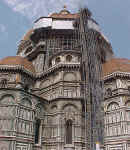
The back part of the Cathedral
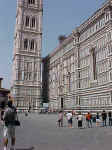
Part of the front of the Cathedral
The really cool part is the Baptistry. In the olden days, you had to be baptized before you
could go into the church. This kind of raised the problem of--if you have to be baptized
before you can go into the church, but you get baptized in a church, how the heck do you get
in to get baptized?
The solution was to build a separate (gigantic) building called a Baptistry, where the only
thing you did was baptize people. Then they could head into the regular church and join the
12,000 person communion line.
The Baptistry door consists of twelve gorgeous panels of gold-covered bronze. The panels are
little 3-D pictures of important scenes from the Old Testament. Back then (500 years ago),
most of the people were peasants, and many of them dropped out of school before they reached
kindergarten. As a result, their reading skills were sub-par. So the pictures taught them the
important bits of the bible.
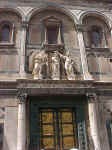
The entrance to the Baptistry
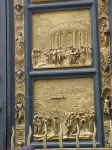
Detail of two of the panels (top: Joseph meets his brothers in Egypt after they kidnapped
him; bottom: Battle of Jericho)
It took the guy who created it about 27 years to finish it(!). Strangely enough, the New
Testament door isn't gilded and only took a couple of years to finish. Guess back then, they
felt the Old Testament was more important.
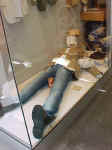
My fashion knocks me out (actual display in store window)
12:53 pm
Our feetsies are killing us, it's hot, and it's time for lunch! Luca takes us to the Hotel
Astoria Restaurant, which is in a whole different dimension that your typical US Hotel
Restaurant.
We get served a lovely red wine (the label says "Generic Table Wine" so we can only
imagine what the good stuff tastes like). Then we get served a vegetable lasagna, followed by
veal with gravy and vegetables. Finally, dessert is peaches buried in white cake with whipped
cream, drizzled with chocolate.
All this is served in a room that is 125 years older than the US (a fairly "new"
room in other words). Them Italians sure understand about food!
2:36 pm
We all waddle back onto the bus, which heads for Pisa. Everybody (everybody) on the bus
(except the driver) immediately participates in the Italian tradition of taking a nap after
lunch. This is so civilized.
3:50 pm
We pull into Pisa and get off the bus about a half-mile from the tower. The famous leaning
tower is pretty much the only touristy thing in Pisa, but then, they don't need a heck of a
lot else.
The first part of the walk is a pleasant amble through tree-covered neighborhoods. Then we hit
Cheesy Souvenir Alley, where you can buy drinks, snacks, and various tacky little souvenirs.
This continues until you reach the park that surrounds the tower and its associated church and
Baptistry.
At that point you hit Incredibly Tacky Souvenir Alley, where you can buy leaning tower
replicas in all sizes from one inch to four feet (some of them filled with olive oil). You can
also buy lighters, plates, towels, posters, key chains, and glasses with pictures of the
leaning tower on them. Also replica guns, crossbows, swords and maces ("Nothing says,
'I've been to Pisa' like a genuine replica mace!").
The tower itself really does lean. The surprising part (to us uneducated Americans at any
rate) was that the tower is the bell tower to a church, which stands right next to it. And
across from the church is a Baptistry, which is even bigger than the one in Florence. There's
also a tomb area that's pretty huge.
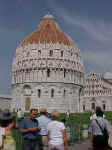
Baptistry (church in background)
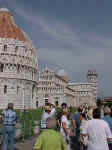
Baptistry, church, and bell ("leaning") tower
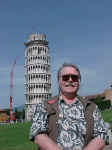
It's not crooked!
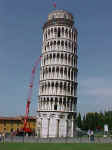
Or is it?
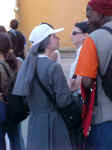
Nun in baseball cap
The whole area is surrounded by medieval walls. In the old days, Moslem pirates liked to
attack Pisa and try to storm the churches so they could burn them and then desecrate the
graves (this was well before TV, so they had to devise other means of entertaining
themselves). So, the churches were always the best protected areas.
We looked at the tower, verified that it does, in fact, lean, took a picture and went back to
the bus (without the souvenir mace, much to Robert's regret).
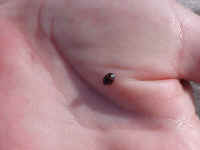
Italian ladybug on Laura's hand
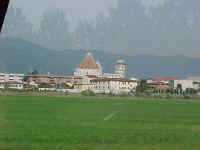
Wave goodbye to the leaning tower, dear
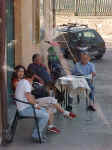
Street scene in Pisa
5:30 pm
We arrive back at the boat, and head for Naples. Touristic adventures there include the
fabulously cool city of Pompeii! Volcanoes! Petrified people! Erotic friezes! Hoo boy!
Robert & Laura
Headed S-SW from Livorno, Italy
|
